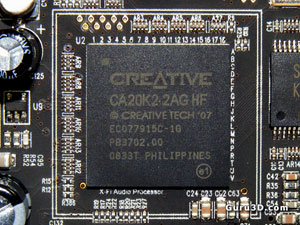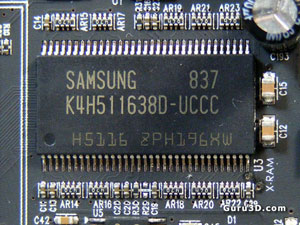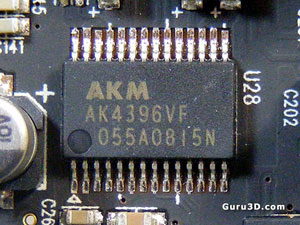Electronics Overview (1)
Electronics Overview
Let's have a peek at what components where used to build this soundcard.
20K2 -X-fi 2 Processor
This chip is the second version of the Famous X-fi DSP processor offer Native PCI-E connectivity.
The 20K2 series chip on the Forte is a hardware Digital Signal processor and offers the user some serious audio muscle for various audio tasks. The X-fi processor offers 51.1 Million (yes, million) transistors dedicated to your audio.

The DSP offers hardware accelerated audio effects and 10,000 MIPS (Million Instructions Per second!) Without bogging this review down with the many parameters and values related to the audio horsepower of the X-fi processor, let's just say it offers approximately 24X more processing power than the Audigy processor. The Main options this card offers that gamers look for is the hardware accelerated EAX 1,2,3,4,5 and OpenAL based in game environmental effects. To note, if your current card does not have a dedicated DSP processor such as the Audigy (10KX) or X-FI (20KX) series Digital signal processors then any and all effects and other routines tax your CPU.
The full range of time and frequency based effects, Sample rate conversion and values related to internal operation of this processor are outside the scope of this review. If you are interested in finding out more about the 20KX series DSP processors you can have a look here: X-FI info link
X-RAM
The Auzentech Forte 7.1 contains 64MB of dedicated RAM, commonly referred to as X-RAM. This on-card RAM space offers a working area for audio task performed on the card by the DSP processor.
X-Ram offers user two main benefits, Game designers can incorporate higher quality sound samples into their games as they can be loaded into the X-Ram dynamically before they are required.
Compressed samples which are common on PC's and especially seen used in games can be decompressed into the X-RAM offering a dynamic buffer area for the designers. Both tasks translate to increases speed and efficiency if incorporated by designers.
With more and more games having audio engines coded for OpenAL, X-RAM becomes more important.
When using OpenAL X-RAM is defaulted to automatically load in audio buffers and requires no further coding by the designers.

DAC AKM AK4396VF and CS4382A (Outputs)
AK4396VF: This DAC offers advanced multi-Bit ?? architecture and provides high quality 24/192 KHz output. We have a Dynamic range of 120dB with a THD+Noise value of -100dB. This DAC also offers 128X oversampling, low sensitivity to jitter and is compatible with frequencies from 32 KHz to 216 KHz.
This Digital to Analog Converter (DAC) handles signals for the Front Left and Right channel outputs and signals for the Headphone outputs for the front and rear connections. This DAC has been seen in many high quality External DAC units and is considered a high quality DAC chip by designers.

